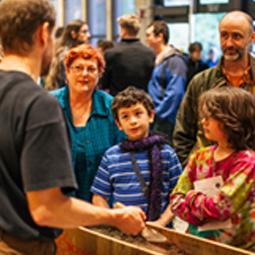[HALF WALL AT ENTRANCE]
hədiẃ ʔə higʷəd enter with respect
This area houses a Woolly Dog.
The Woolly Dogs were nurtured and revered by the Coast Salish peoples who cared for them. Their wool was used for weavings.
Many communities in this area have deep ties to the Woolly Dog. Please honor these relationships by entering with respect.
If this space is full, please come back at a less busy time.
[WALL BEHIND THE WOOLLY DOG]
“They were like royalty to our people.
We raised them separately from all the other breeds, combed them, and took great care of them.
The Woolly Dog’s hair is what we used to create our blankets and our tunics, our headbands, and our skirts.”
— Qw3’May Usia Tahnee Hawk Miller, Skokomish
[CASEWORK ALONG WALL]
Recent scientific inquiry is catching up to long-held Salish knowledge.
Coast Salish peoples have known the history of the Woolly Dog for generations. Their existence as a breed goes back 5,000 or more years.
Collaborative projects are bridging Indigenous histories with DNA testing to both underscore weaving histories, and reveal new information about the breed itself.
The Woolly Dog Mutton came from Sto:lo territory and was the pet of Smithsonian ethnologist George Gibbs. When Mutton died in the fall of 1859, his pelt was preserved. In 2023, genomic and isotopic testing was integrated with Coast Salish histories to reveal the long presence and unique characteristics of the Woolly Dogs.
A 2023 article in Science magazine tells the story of scientists and Coast Salish knowledge keepers working together to study the Woolly Dog Mutton, whose pelt is displayed here.
This Woolly Dog reconstruction image is shown at scale with Arctic dogs and spitz breeds in the background for comparison; the portrayal does not imply a genetic relationship.
Image published in: Audrey T. Lin et al., The history of Coast Salish “woolly dogs” revealed by ancient genomics and Indigenous Knowledge. Science 382, 1303-1308 (2023).
Right
sqwemáy (Sto:lo Language)
“Woolly Dog”
His name was Mutton
1850s
Loan courtesy of the Division of Mammals, Department of Vertebrate Zoology, National Museum of Natural History, Smithsonian Institution
Treasured by Salish peoples for generations, Woolly Dogs were considered family.
Many communities bred these dogs over millennia specifically for their long, warm, luxurious wool.
To assure the whiteness and wooliness of their coats, they were carefully guarded and kept away from hunting and village dogs on islands and in pens.
Honored and cared for by women, the dogs provided the gift of their fur for weavers to spin and use in weaving. Woolly Dogs were the wealth of many Salish communities—their languages had specific words to differentiate them from the other dogs, reflecting their unique status. In Lushootseed, this word is sqix̌a.
Today, the Woolly Dog as a specific breed has died out.
There are many reasons why, but all stem from colonization. Governments enforced treaties, moved people to reservations, limited fishing, and sent children to residential schools where cultural language and practices were banned. As a result, the ability to provide care for these special dogs was damaged. The breed was lost.
During the 20th century, the descendants of these Woolly Dogs continued to be companions. However, they had begun to interbreed with other dogs and so their fur was no longer used in weaving.
Left
sqwemáy (Sto:lo Language)
“Woolly Dog”
His name was Mutton
1850s
Loan courtesy of the Division of Mammals, Department of Vertebrate Zoology, National Museum of Natural History, Smithsonian Institution
(Image Caption) Paul Kane (1810 - 1871) Detail from Clallam Woman Weaving a Basket, Watercolor and pencil on paper, 1847
